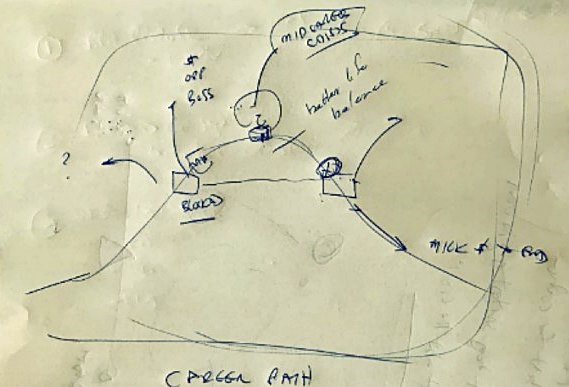What decisions had the biggest impact on your career? Has your journey been a straight path or a rollercoaster? If you are a CIO, was that your original goal?
Sometimes it takes a random encounter to make you think about those questions. In Dave’s case, it was prompted by a reunion with former colleagues at a huge wedding in India. All of them had become CIOs and shared a connection with the father of the groom. During a break in the multi-day festivities, they started sharing workplace stories. Despite their widely different backgrounds, industries and starting points, it turns out they all shared a common career arc.
Later, the two of us discussed the arc of a CIO career while considering the type of CIO we sought for our firm, Perpetua Advisors. Like all good CIOs, we felt the need to sketch it out, so Mike grabbed a napkin and we started drawing what would be become seven stages of the CIO career.

CIO Career Arc- first draft
The discussion and sketching exercise quickly expanded into an in-depth analysis of the CIO career path. What we found most fascinating was not the arc itself - which is fairly standard - but the stages on the journey and the inflection points which changed the course.
We identified seven distinct stages, each marked by a critical decision to continue. The path is not linear and often volatile. Some people find IT, others wind up in IT.
Stage 1: Apprentice
The entry stage into the IT profession ranges from software development to infrastructure support to help desk. Everyone in IT remembers their first job, sometimes with fondness, other times with near-regret.
The critical decision point comes relatively quickly: “Do I want to continue in this profession?” Many decide to exit at this point, but some return later at a higher stage.
Stage 2: Workhorse
Once you decide to continue, you enter the “grinding” stage. You are likely assigned to projects or technical roles with longer hours and more difficult challenges. You suffer frequent stumbles as you gain critical skills and experience. Frustration may be high, as you witness the Business vs. IT divide first-hand.
This decision point becomes “Do I ever want to lead IT? Or am I comfortable in my current role?” Many talented IT professionals prefer to remain as individual contributors rather than manage IT or become a CIO. These professionals form the lifeblood of a healthy IT organization and may eventually lead large organizations within their area of IT expertise.

Seven Stages of a CIO Career - a clearer picture
Stage 3: Fast Track
If you want to lead, this stage provides an opportunity to make a mark. It might be leading a key project, providing insight at the right time or even pure luck. It is during this stage that the individual gains visibility beyond the IT organization. They become a confidante or heir apparent to the current CIO and are often designated as a "high-potential" within a company’s career development program. They are close enough to the CIO role to understand its implications. It is also when outside recruiters start to call about potential CIO opportunities at other companies.
This is the gateway to becoming a full-fledged CIO, whether at their existing company or another organization. The internal questions are “Am I ready? Do I really want the job?” The alternative is to accept a CIO inner circle role, such as the trusted #2 or strategic advisor. Some individuals may like the idea of leading IT, but do not want the political aspects of the top job.
Stage 4: CIO
Now the fun starts and the “straight line” career arc becomes more like a roller coaster ride. This stage includes ups and downs driven by organizational changes, technology challenges, political battles, strategic shifts and more. It may include multiple job changes, and recruitment into other jobs. A CIO’s path is similar to a head coach in a professional sport, with the same job security.
|
Related Career Resource: |
The excitement of the ride is often offset by moments of despair and frustration. Every CIO has a day where they wonder why they took the job in the first place. They may love what they do, but they still ask “Is it worth it?” The good news is that once you have the title, you will always have options. However, the day will come where you decide to get off the roller coaster and take a different approach to your life and career.
Stage 5: Mentor/Consultant
If the CIO still wants to work, they often shift into an advisory role for a new CIO or new leadership team. Their insight and perspective help provide a smooth transition to a new organization. The distinction is that they provide mostly advisory services as opposed to operational leadership.
These individuals can still provide immense value to an organization, but there is a “best if used by” date for their expertise. At some point, the battle scars and experiences are no longer relevant. Valuable insight becomes tired clichés. It is up to the individual to exit gracefully when they realize they are repeating the same stories.
At this point, the person officially retires or becomes a consultant, whether on their own or through another firm. If they choose this path, they must either tailor their expertise to a new challenge or develop new skills - or else lapse into the next stage.
Stage 6: Out of Touch
This is the danger zone within the CIO career arc. The stories have officially become old, the skill set is out of date and the joys of solving problems have disappeared. Just like in sports, no one likes to admit they cannot play in the pros anymore. However, it is better to exit too soon than too late. Everyone in IT knows someone in this stage. Don’t let it be you.
Stage 7: Out to Pasture
This stage is not something to dread, but to enjoy. Become a user of the wonderful world of technology, not a manager of technology. Get a new mobile device. Learn new skills, but beware of social media. You will always be CIO of the household. No surprise: all of the new technology still follows many of the same rules as when you started in the IT industry many years ago. Yes, some of your stories are timeless, despite what the young guns say.
And of course, you can always create a brand new arc. Become CEO - and mentor a CIO - or start your own business using that wealth of experience. Dave’s journey included two exits and re-entries, finally exiting for good to start another business. Not everyone is meant for pasture.
What about you? We welcome your comments below!

Written by Dave Patzwald and Mike Wind
Dave Patzwald and Mike Wind are former CIOs who launched Perpetua Advisors, which helps companies translate tech speak into business language and make the right decisions.


